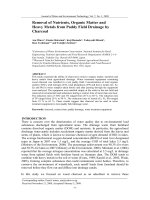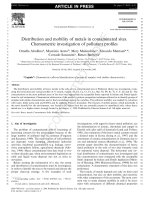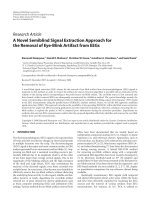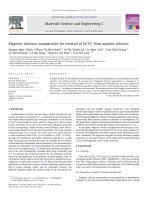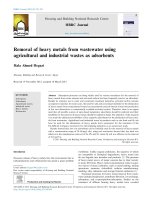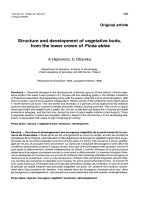Development of novel titanate nanotubes reduced graphene oxide composite for the removal of heavy metals from aqueous solution
Bạn đang xem bản rút gọn của tài liệu. Xem và tải ngay bản đầy đủ của tài liệu tại đây (1.25 MB, 50 trang )
THAI NGUYEN UNIVERSITY
UNIVERSITY OF AGRICULTURAL AND FORESTRY
VU THI HOAI
TOPIC TITLE: DEVELOPMENT OF NOVEL TITANATE NANOTUBES/
REDUCED GRAPHENE OXIDE COMPOSITE FOR THE REMOVAL OF
HEAVY METALS FROM AQUEOUS SOLUTION
BACHELOR THESIS
Study Mode: Full-time
Major: Environmental Science and Management
Faculty: International Training and Development Center
Batch: 2010-2015
Thai Nguyen, 15/01/ 2015
1
DOCUMENTATION PAGE WITH ABSTRACT
Thai Nguyen University of Agriculture and Forestry
Degree Program
Bachelor of environmental Science and Management
Student name
Vu Thi Hoai
Student ID
DTN1053110084
Thesis Tiltle
Supervisor(s)
Development of Novel Titanate Nanotubes/ Reduced
Graphene Oxide Composite for the Removal of Heavy
Metals from Aqueous Solution
Prof. Dr. Nguyen The Dang, Thai Nguyen University of
Agriculture and Forestry, Vietnam
Prof. Ruey-an Doong, National Tsing Hua University
Abstract
Graphene oxide (GO), is a two dimensional carbon nano-material which exhibits a
great adsorption potential. Graphene functionalized composites enhance its adsorption
efficiency for toxic heavy-metals from contaminated waste water. Titanium nanotubes
and GO were assembled in basic medium via microwave-assisted hydrothermal
method. The strong anchoring of TNT on the surface of GO sheets can be easily
observed by TEM (Transmission Electron Microscopy), XRD (X-ray Diffraction).
Diffraction on GO sheets confirmed through D-band and G-band ration by Raman
Spectroscopy. As-synthesized TNT/rGO composite shows high efficiency and high
selectivity toward heavy metals in aqueous solution. The results indicated that
TNT/rGO composite with high adsorption efficiency and fast adsorption equilibrium
can be used as a practical adsorbent for heavy metals in aqueous solution.
Keywords
Titanate nanotube, Graphene oxide, composite,
hydrothermal, adsorption
Number of papers
44 pages
Date of submission:
15/01/2015
2
ACKNOWLEDGEMENTS
I am deeply indebted to my research supervisor Prof. Ruey-An Doong, whose
stimulating motivations and valuable ideas helped me to complete my thesis and I
would like to offer my sincere gratitude to prof. Dr. Nguyen The Dang for his
support throughout my thesis with his patience and knowledge whilst allowing me the
room to work in my own way. I attribute the level of my Bachelor degree to his
encouragement and effort.
I am grateful to Rama Shanker Sahu (PhD) and Yen-Tung Yang (PhD) for
their valuable help, advices and constructive comments during all my experiments and
writing thesis.
I would like to thank Duncan, Sammy, Joyce (MS) for their great support in
characterizing my samples, YC Ken Tsai (PhD) and Rudy (PhD) for their impressive
help in adsorption studies.
I would also like to thank Khanh, Linh and all FATECOL members,
Biomedical Engineering and Environmental Sciences, National Tsing-Hua University,
Taiwan, who provided their ongoing support, questions and suggestions.
Finally, I would like to express my love and gratitude to my beloved parents for
their support & endless love.
VU THI HOAI
3
TABLE OF CONTENTS
LIST OF FIGURES ....................................................................................................... 1
LIST OF TABLES ......................................................................................................... 2
LIST OF ABBREVIATIONS ....................................................................................... 3
PART I. INTRODUCTION .......................................................................................... 4
1.1. Research rationale .............................................................................................. 4
1.2. Research's Objectives ......................................................................................... 6
PART II. LITERATURE REVIEW ............................................................................ 7
2.1. Overview of heavy metals ................................................................................... 7
2.1.1. Definitions and sources of heavy metals .........................................................7
2.1.2. Characteristics of heavy metals.......................................................................7
2.2. Heavy metal pollution in the world and Vietnam............................................ 8
2.2.1. In estuary, coastal and marine areas ..............................................................8
2.2.2. In acid sulfate soil areas ..................................................................................9
2.3. Characteristics and hazards of some heavy metals ....................................... 10
2.3.1. Arsenic (As) ....................................................................................................10
2.3.2. Cadmium (Cd) ................................................................................................11
2.3.3. Lead (Pb)........................................................................................................12
2.3.4. Copper (Cu) ...................................................................................................13
2.4. Effects of heavy metal to environmental and human health ........................ 14
2.5. Some of treatment methods for the removal of heavy metals from aqueous
solution ....................................................................................................................... 15
2.5.1. Carbon materials ............................................................................................15
2.5.2. Phytoremediation ...........................................................................................18
2.5.3. Nanomaterials ................................................................................................19
2.5.4. Titanate nanotubes .........................................................................................19
4
2.6. Overview of handling heavy metals in aqueous solution using Titanate
nanotube / reduced graphene oxide composite. .................................................... 20
2.6.1. Scientific Basis of handling heavy metals in aqueous solution by rGO-TNT
composite .................................................................................................................20
2.6.2. Some research results of absorption of heavy metals in water by rGO-TNT
composite .................................................................................................................20
2.6.3. Prospects of technological rGO-TNT composite in removal of heavy metals
in aqueous solution. .................................................................................................21
PART III. METHODS ................................................................................................ 22
3.1. Materal ............................................................................................................... 22
3.1.1. Chemicals .......................................................................................................22
3.1.2. Instruments .....................................................................................................22
3.2. Methods .............................................................................................................. 23
3.2.1. Synthesis of TNT ..........................................................................................23
3.2.2. Synthesis of Graphene oxide .........................................................................24
3.2.3. Synthesis of rGO-TNT Composite ................................................................25
3.2.4. Adsorption Experiment ..................................................................................25
3.2.5. The method of determining the characteristics of the material ....................27
PART IV. RESULTS ................................................................................................... 32
4.1. Characterization of GO and titanate nanotubes/rGO composite. ............... 32
4.2. Morphology of TNT, GO and rGO-TNT composite. .................................... 35
4.3. Application into removal of heavy metal ions ................................................ 36
PART V. DISCUSSION AND CONCLUSION ....................................................... 39
5.1. Discussion ........................................................................................................... 39
5.2. Conclusion .......................................................................................................... 40
REFERENCES ............................................................................................................. 42
5
LIST OF FIGURES
Figure 3.1. Schematic of TNT synthesis.………………………….........................…24
Figure 3.2. Schematic of GO synthesis……...………………………..……...…….....25
Figure 3.3. Adsorption experiment of Copper by TNT and rGO-TNT ………………27
Figure 3.4. Atomic adsorption spectroscopy (AAS)……………………...…..……....28
Figure 3.5. Raman spectroscopy……………………………………………………...30
Figure 3.6. Schematic of TEM …………………………….…………….........……...31
Figure 3. .7. The process TEM characterization……...………………………… ..….32
Figure 4.1. Raman spectra of GO, rGO-TNT materials…………….……………..…33
Figure 4.2. XRD patterns of GO………………………………………………...........34
Figure 4.3. XRD patterns of TNT and rGO-TNT composite……………...…….........35
Figure 4.5. TEM images of the synthesis TNT and rGO-TNT composite…………....36
Figure 4.6. The adsorption of Cu(II) by TNT at pH=5 in aqueous solution at room
temperature.……………………………………………………………….…........…..37
Figure 4.7. The adsorption of Cu(II) by rGO /TNT composite in aqueous solution at
room temperature.…………………………..……….…..............................................38
1
LIST OF TABLES
Table 4.1. The results of Cu (II) adsorption experiment by TNT, was observed by
Atomic adsorption spectroscopy (AAS). ……………………………………………37
Table 4.2. The results of Cu (II) adsorption experiment by rGO-TNT, was observed by
Atomic adsorption spectroscopy (AAS)……………………………………………..38
2
LIST OF ABBREVIATIONS
Abbreviations
Full text content
TNT
Titanate nanotube
GO
Graphene oxide
TNT-rGO
Titanate nanotube and reduced graphene oxide
XRD
X-Ray Diffraction
TEM
Transmission Electron Microscopy
AAS
Atomic adsorption spectroscopy
3
PART I. INTRODUCTION
1.1. Research rationale
Pollution of air, water and soil is a worldwide issue for the eco-environment and
human society. Most of the earth's surface is covered by water, and most of the human
body is composed of water. These are the two facts illustrating the critical linkages
between water, health and ecosystems. It can be seen that, water is the most essential
compound on the earth for the human activities. Providing clean water is the prime
requirement of the human being for their better health. Since the fast growing sector of
industries, expansion of population, and urbanization have largely contributed to the
severe contamination of water, air and soil. Chemical and fertilizers use in domestic
and agricultural activities leads to the lifetime threatening diseases. Intense use of
heavy metals in industries for dyeing, paint etc. is becoming one of the most serious
environment problems globally. Its presence in low concentration of heavy metals in
various water resources could be harmful to human health. The treatment of heavy
metals is so important due to their persistence in the environment.
In order to remove the heavy metals, various techniques have been developed. The
traditional treatment processes for heavy metals include chemical precipitation,
electrolysis, adsorption, and ion exchange. Among these methods, adsorption is an
efficient technology, which has been widely used for the removal of metal ions in
aqueous solutions. A wide variety of adsorbents including activated carbon, water
treatment sludge, zeolite, fly ash, and biomass have been reported to effectively adsorb
metal ions, showing varying extent of effectiveness in removing the toxic pollutants
from air, water and soil.
4
More recently, one-dimensional (1-D) titanate nanotube (TNT) have been reported to
be an attractive adsorbent to effectively adsorb a wide variety of metal ions including
Cu, Pb, Cd, and Zn because of their large specific surface areas and layered structures.
TNT is considered as a modified structure in photo catalysis owing to its special
electronic and mechanical properties, high photo catalytic activity, large specific
surface area and high pore volume, a potential material for removal of metal ions in
the aqueous solution.
Besides, in the past few years, Graphene oxide (GO) have attracted tremendous
interest in the world. Graphene is a two-dimensional carbon nanomaterial with single
layer of sp2 hybridized carbon atoms arranged in six membered rings. Graphene has
strong mechanical, thermal, and electrical properties with a theoretical value of
specific surface area at 2630 m2/g. GO is a functionalized graphene with varying
oxygen containing groups. Several views have been reported on applications of GO in
different areas such as physics, chemistry, biology, and material science. In particular,
graphene based materials are used as adsorbents for pollutants removal since graphene
oxide possesses several functional groups and has strong acidity, exhibiting high
adsorption for basic compounds and cations. Graphene also has a hydrophobic surface
and presents high adsorption to chemicals due to strong π–π interaction.
Among several physical, chemical and biological treatment techniques, the adsorption
is one of the simplest, fastest and most efficient processes or the removal of heavy
metals. Considering all aspects and issues mentioned above, I have paid attention to
the preparation of titanate nanotube/reduced graphene oxide composite and
subsequently used them as adsorbents.
5
1.2. Research's Objectives
The primary objective of this study is to develop and investigate a graphene based
nano composite for the removal of toxic heavy metals from aqueous solution.
Titanium nanotubes and GO were assembled in basic medium via microwave-assisted
hydrothermal method.
Estimation of the adsorption capacity of some heavy metal ions in aqueous solutions.
Characterization of material composites using techniques like XRD, TEM, SEM,
FTIR, Raman Spectroscopy.
Synthesizing the TNT and performing the adsorption experiments to evaluate its
properties.
The fabrication of new materials Titanate nanotubes / reduced graphene oxide
composite will make a significant contribution in wastewater treatment produced due
to mining in the country and improving the domestic water efficiency as well as
contributing to the environmental protection.
6
PART II. LITERATURE REVIEW
2.1. Overview of heavy metals
2.1.1. Definitions and sources of heavy metals
The origin of the term "heavy metal" is not clear. An early use dates from 1817, when
Gmelin divided the elements into nonmetals, light metals and heavy metals (Habashi F
2009). Light metals had densities of 0.860–5.0 gm/cm3; heavy metals 5.308–22.000
(Gmelin L 1849). Heavy metals are divided into three types: toxic metals (Hg, Cr, Pb,
Zn, Cu, Ni, Cd, As, Co, Sn etc.), precious metals (Pd, Pt, Au, Ag, Ru etc.), radioactive
metals (U, Th, Ra, Am,etc.).The proportion of these metals is usually greater than
5g/cm3 (Bishop, 2002).
Heavy metals are found naturally in the earth, which become concentrated as a result
of human caused activities. Common sources are from mining and industrial wastes;
vehicle emissions; lead-acid batteries; fertilizers, paints and treated woods. Lead is the
most prevalent heavy metal contaminant.
2.1.2. Characteristics of heavy metals
Heavy metals are not biodegradable (Tam & Wong, 1996) and are non-toxic in the
form of elements, but are dangerous to living organisms when they are in the form of
cations due to its linkage capacity with short carbon chain, which leads to the
accumulation in the organism after several years. For humans, approximately 12
elements of heavy metals cause toxic such as lead, mercury, aluminum, arsenic,
cadmium, nickel ... Some heavy metals are found in the body and essential for human
health, such as iron, zinc, magnesium, cobalt, manganese, molybdenum and copper,
although the amount is very small but it is present in metabolism. However, at excess
7
level of the essential elements can endanger the life of the organism (Foulkes, 2000).
The remaining metal elements are unnecessary elements and can be highly toxic when
present in the body; however, the toxic is only present when they enter the food chain.
These elements include mercury, nickel, lead, arsenic, cadmium, aluminum, platinum
and copper in the form of metal ions. They enter the body through the streets of the
body to absorb as respiratory, gastrointestinal and through the skin. If heavy metals
enter the body and accumulate inside the cell is greater than the resolution of them,
they will increase and the poisoning will appear (Foulkes, 2000). The toxicity of heavy
metals is expressed through:
(1) Some of heavy metal can be moved from low to higher toxicity in the form of
some environmental conditions, such as mercury.
(2) Accumulation and biological amplification of these metals through the food chain
may damaging the normal physiological activity and ultimately endanger human
health.
(3) Toxicity of these elements may be at a very low concentration of about 0.1-10
mg.L-1 (Alkorta et al., 2004).
2.2. Heavy metal pollution in the world and Vietnam
2.2.1. In estuary, coastal and marine areas
Metal pollution in the marine environment has increased in recent years due to
increasing global population and industrial development. Heavy metal pollution in
many estuaries, coastal areas around the world have long been known by toxic threat
to the life of aquatic organisms, risk to human health.
Pb and Zn pollution is one of great concern due to their toxic effects on the ecosystem
in the estuaries in Australia, with very high levels of 1000µg.g
-1
Pb, 2000 µg.g-1 Zn
8
can be found in the contaminated sediments. Bryan et al. (1985) quoted in Bryan &
Langston (1992) was determined the amount of inorganic lead in estuaries sediments
in the UK ranged from 25 μg.g-1 in non-contaminated areas to over 2700 μg.g-1 in
estuary Gannel where get the waste from the mining of lead. Concentrations of lead
compounds are probably originated from the use of leaded petrol.
Similarly Pb, As concentration has been identified in many estuaries, coastal areas in
the world. As concentrations in estuarine sediments were determined from 5 μg.g -1 in
the Axe estuary to more than 1,000 μg.g-1 in the estuary Restronguet Creek, Cornwall
where get wastewater from the mining area metal.
Cd concentrations were determined in the UK in the estuary are not contaminated with
levels of 0.2 μg.g-1, in the estuaries were heavily polluted the concentration may be up
to 10 μg.g-1 (Bryan & Langston, 1992). Deule River in France is one of the rivers are
serious polluted by suffered waste from metallurgical plants. Metal concentrations in
sediments of the river are very high (480mg.kg-1). Concentrations of heavy metals in
sediments in estuaries, coastal areas in the world where there are mangroves also
identified from less polluted to heavily polluted.Tam& Wong (1995) were determined
Pb concentration in sediments of mangrove Sai Keng, Hong Kong with concentration
58,2 µg.g-1. Zheng & Lin (1995) were determined Pb and Cd concentration in
sediments of mangrove Avicennia marina, Shenzhen Bay with corresponding levels of
28,7 µg.g-1 and 0,136 µg.g-1 respectively.
2.2.2. In acid sulfate soil areas
According Astrom & Bjorklund (1995) was shown that acid sulphate soil is source
release of heavy metals make aqueous solution pollution. When potential acid sulphate
soil exposed to oxygen by natural phenomena or by artificial drainage, pyrite oxidized
9
creates acid sulfuric lowers pH. When pH <4 protons are released to attack the clay
minerals, dissolved some of metals that their concentration may be exceed
concentration in soil without acid sulphate.
2.3. Characteristics and hazards of some heavy metals
2.3.1. Arsenic (As)
Arsenic distributed in many places of environment, they are ranked No.20 in the
presence of many elements in the Earth’s crust, present less than Cu, Sn, but more than
Hg, Cd, Au, Ag, Sb, Se (Bissen& Frimmel, 2003). Source giant arsenic release into the
atmosphere by natural processes is of volcanic activity. During volcanic activity, a
large amount of approximately 17,150 tons of arsenic release into the atmosphere
(Matschullat, 2000).
Sources of pollution due to human activity:
Mining ore (Cu, Ni, Pb, Zn), metallurgy releases into environmental a large amount of
arsenic. Approximately 62,000 tonnes of arsenic release into the environment every
year from these activities.
Burning of fossil fuels from the household, from the power plant.
Use fungicides, herbicides, insecticides and industrial
Since when put to use DDT in 1947 and the organic pesticides containing
organic arsenic compounds.
The harmful effects of arsenic on human health:
Toxicity of arsenic depends very much on the nature of the compounds that form,
especially is valence. Arsenic vanlence 3 is more toxic than vanlence 5. Toxicity of
inorganic arsenic (arsenic tri-oxide) in humans has been known for a long time. Lethal
dose about 50-300mg but depend on the individual (Clark et al.,1997). The expression
10
of chronic arsenic poisoning include: weakness, loss of reflexes, tiredness, gastritis,
colitis, anorexia, weight loss, hair loss, etc. Human is poisoned Arsenic in long term
through food or air leads to cardiovascular disease, disorders of the nervous system,
circulatory, brittle nails brittle nails with horizontal white lines, liver dysfunction,
kidney (Bissen & Frimmel, 2003). Acute arsenic poisoning can cause nausea, dry
mouth, dry throat, pulled muscles, stomachache, itchy hands, itchy legs, blood
circulation disorders, neurasthenia, etc.
2.3.2. Cadmium (Cd)
Cd is present everywhere in the earth's crust with an average concentration about
0.1mg.kg-1. However, higher concentration can be found in sedimentary rocks such as
marine sedimentary rock often contains about 15mg.kg. Annually rivers transport a
large amount of Cd approximately 15,000 tons into the ocean. Concentration of Cd has
been reported to be up to 5mg.kg-1 in the river and lake sediments, from 0.03 to 1
mg.kg-1 in the marine sediments.
11
Source by human activity:
The major application of Cd in the industry such as steel protective coating,
stabilizer in PVC, pigments in plastics and glass, and in many components of
the alloy is one of the causes release like Cd in the environment.
Concentration of Cd in phosphate fluctuates different, depending on the source
of phosphate rock. Phosphate fertilizer is derived from North Carolina
phosphate rock containing Cd 0.054g.kg-1, derived from Sechura rock
containing concentration of Cd 0.012g.kg-1, whereas phosphate fertilizer is
derived from phosphate rock Gafsa containing 0.07g.kg-1
The harmful effects of Cd on human health:
Cadmium is known to cause damage to the kidneys and bones at high doses. Studied in
1021 men and women is infected Cd in Sweden showed that metal poisoning is related
to increased risk of fractures over the age of 50. Itai-itai disease is caused by the
serious Cd poisoning. All patients with this disease are all compromised kidney, bone
pain become brittle and break easily.
2.3.3. Lead (Pb)
The average of lead content in the lithosphere estimated 1,6x10 -3weight percent, while
the average land 10-3 percent and normal fluctuations around 0,2x10 -3 to 20x10-3
percent. Lead is present naturally in soil with average content 10-84 ppm.
Source by human activity:
Lead is used in batteries, the battery, in some instruments conductivity. Some
lead compounds are added in paint, glass, ceramics, such as colorants,
stabilizers, binder.
12
The waste products from the application of lead if not recycled properly, when
released into the environment will increase the amount of this toxic metal. Also
some organic lead compounds such as lead tetrametyl or tetraetyl added in
gasoline, especially in developing countries.
The harmful effects of lead on human health:
In the human body, Pb in the blood associated with erythrocytes, and accumulated in
the bone. The ability to remove lead from the body is very slowly, primarily in the
urine. Half-life of lead in the blood is about a month, in bones of 20-30 years. The
organic lead compounds are sustainable, harmful to humans, can lead to death.
The expression of acute lead poisoning, such as headache, irritability, excitability, and
many different expressions related to the nervous system. Humans infected long term
may lead to memory loss, decreased ability to understand, reduced IQ, scrambling
ability to synthesize hemoglobin can lead to anemia. Lead is known to be the cause of
lung cancer, stomach and gliomas. Lead poisoning can cause harmful effects on
reproductive capacity, miscarriage.
2.3.4. Copper (Cu)
Copper is found naturally in minerals such as cuprite (Cu2O), malachite
(Cu2CO3.Cu(OH)2), azurite (2CuCO3.Cu(OH)2), chalcopyrite (CuFeS2), chalcocite
(Cu2S), and bornite (Cu5FeS4) and in many other organic compounds. Ion Cu(II) Cu
(II) linked through oxygen to the inorganic agents such as H2O, OH-, CO32-, SO42-,...
for organic agents across the group like phenolic and carboxylic, so most of copper in
the natural complexes with organic compounds . In the lava rock is co-variation from
4-200mg.kg-1, in sedimentary rock 2-90mg.kg-1.
The harmful effects of Copper on human health:
13
Copper is considered to be one of the elements necessary for human development, but
the accumulation of copper with high concentrations can be toxic to the body.
Cumings (1948) quoted in WHO (1998) discovered copper is actually toxic agents for
Wilson patients and discover that the liver and brain of these patients contained metal
content is very high.
2.4. Effects of heavy metal to environmental and human health
Environmental pollution due to toxicity of heavy metals cause ecological imbalance,
degrade many populations organisms have been found in many countries around the
world. The Severn Estuary is one of the largest rivers in Britain, is home and
reproduction for many species of fish. Decades, the river has suffered many pollutants
from heavy metals such as lead, cadmium and other elements from various sources.
The effects of this pollution can be one of the causes make declining fish populations.
Fish population in the Severn Estuary river has increased again when the level of water
pollution reduction.
When organisms live in polluted environment, the ability to accumulation of pollutants
in their body is very high, especially is metal pollution, risk to the health of our
consumers through the food chain. Ohi et al. (1974) quoted in WHO (1985) was
determined the level of lead in the blood, in the femur and in the kidneys of pigeons
were collected from rural and urban areas in Japan. The results showed that the highest
level of lead in the femur of pigeons with an average value ranged from 16.5 to 31.6
mg.kg-1 in urban areas. While the average value of 2.0 and 3.2 mg.kg-1 in rural areas.
In the blood, lead levels also have similar trends from 0.15 to 0.33 mg.L-1 in urban
areas, and from 0.054 to 0.029 mg.L-1.
14
In recent years, serious impacts of Arsenic on the human health also have been
reported in India, China, Bangladesh. Estimated that millions of people at risk of
poisoned by poisoning As. Vietnam has about 10 million people in the red river delta,
500 thousand to 1 million people in the mekong delta chronic poisoned by drinking
water from drilled wells containing Arsenic. Similarly, the accumulation of Cd in the
liver and kidney of grazing animals in Australia and New Zealand affect the
consumption of meat products in the country and export to foreign countries.
2.5. Some of treatment methods for the removal of heavy metals from aqueous
solution
There are many different technological solutions to water pollution treatment;
however, when applying any solution to clean water should also interest in the
effectiveness of the process is shown through the main aspects as follows:
Ability to effectively apply in practice.
Reasonable price.
Method of conducting is simple, easy to operate.
Need of resources and energy to maintain the treatment process at a minimum.
Sustainability is high; reduce long-term risk to aquatic environment.
The processing time is fast.
The ability to easily accept the method.
2.5.1. Carbon materials
2.5.1.1. Graphene
Graphene is a type carbon material as nanosorbent, which is a kind of one or several
atomic layered graphites, possesses special two-dimensional structure and good
mechanical, thermal properties. Zhao et al. (2011) synthesized the few-layered
15
graphene oxide nanosheets through the modified Hummers method, this graphene
nanosheets are used as sorbents for the removal of Cd 2+ and Co2+ ions from aqueous
solution, results indicate that heavy metal ions sorption on nanosheets is dependent on
pH and ionic strength, and the abundant oxygen-containing functional groups on the
surfaces of graphene oxide nanosheets played an important role on sorption. (Chandra
et al,. 2010) reported magnetite-graphene adsorbents with a particle size of ~10 nm
give a high binding capacity for As3+ and As5+, and the results indicate that the high
binding capacity is due to the increased adsorption sites in the graphene composite.
(Dana Fialova et al., 2010) was focused on isolation of heavy metals by nanomaterial
approach with subsequent metal detection by electrochemical methods. The aim of
their experiment were to isolate cadmium from solution using adsorbents, such as the
graphene, expanded carbon and multi-wall carbon nanotubes. After 1 hour of
interaction, it has been established that 99 % of cadmium was adsorbed on the surface
of graphene. Graphene was evaluated as the most effective adsorbent that could be
used for application in industrial field for example the decontamination of wastewater.
2.5.1.2. Graphene oxide
Graphene oxide (GO) is chemically modified graphene prepared by oxidation and
exfoliation. Graphen oxide is a monolayer material with high oxygen content. Thin
membranes that allow water to pass through but block off harmful gases are a major
use for GO.
GO is a potential adsorption for metal ion complexation through both electrostatic and
coordinate approaches. Yang et al. (2010) investigated Cu2+ GO interaction in aqueous
solution and reported that Cu2+ causes GO sheets to be folded and also to form large
16
aggregates. The coordination between Cu2+ and oxygen atoms on GO is the primary
driving force and GO has Cu2+ adsorption capacity of 46.6 mg/g, higher than that of
carbon nanotubes(28.5mg/g) and active carbon (4-5mg/g).
2.5.1.3. Reduced graphene oxide
The fabrication of reduced graphene oxide (rGO) and metal oxide composites has
attracted enormous attention, especially in environmental remediation technology,
because the material is easily prepare, inexpensive, environmental friendly and it is
strongly developed worldwide. Chandra et al. (2010) applied magnetite-graphene
hybrids to remove arsenic species, whose present in the drinking water in wide regions
of South Asia has been a huge problem. They found that the high binding capacities,
3.35-4.23mg/g for As(V) and 6.21-7.81mg/g for As(III), were obtained over the
composites due to the increased adsorption sited in the composite which occurred by
reducing the aggregation of bare magnetite. He et al. (2010) successfully grafted
surface-modified Fe3O4 nanoparticles onto GO by covalent bonding in order to
improve the adsorption capacities for methylene blue and neutral red cationic dyes up
to 190.14 and 140.79mg/g, much higher than other adsorbents reported previously.
Zhang et al. (2011) also applied this type of composite to eliminate tetracycline, a
model antibiotic contaminant that is consumed in huge amount annually worldwide as
well as discharged into soil and water. The maximum amount of tetracycline adsorbed
on to 6 nm Fe3O4-rGO was determined to be 95mg/g. Recently, Sreeprasad et al.
(2011) synthesized rGO-MnO2 and rGO-Ag composites to uptake Hg (II) in
wastewater. They gave a high distribution coefficient, greater than 10 l/g, as well as
very good performance for removing heavy metal ions.
17
2.5.2. Phytoremediation
Phytoremediation describes the treatment of environmental problems through the use
of plants that mitigate the environmental problem without the need to excavate the
contaminant material and dispose of it elsewhere.
The basis of this method is that the phenomenon of many species (aquatic plants,
algae, fungi, bacteria etc.) has the ability to retaining on the surface or receiving into
inside the cells of their bodies the existence of heavy metals in soil and water
(Biosorption).
The biological methods for handling heavy metals include:
Using anaerobic microorganisms and aerobic.
Use of aquatic plants.
Use of biomaterials.
Rahman et al. (2011) investigated phytoremediation of arsenic by common aquatic
macrophytes. Phytoremediation of contaminated water by aquatic macrophytes would
be a good option in long term. A large number of aquatic plant species have been
tested for the remediation of toxic elements from fresh water systems. Few aquatic
plants (mostly macrophytes) have shown the ability to accumulate high level of arsenic
from water. Among those aquatic plants, water hyacinth (E. crassipes), duckweed
(Lemna, Spirodela, and Wolffia), water fern (Azolla spp.), Hydrilla (H. verticillata),
and watercresses (N. officinale, N. microphyllum) have been proposed to be potential
for phytoremediation due to their arsenic hyperaccumulation ability and growth habit.
A number of studies revealed that phytoremediation of arsenic using aquatic
macrophytes would be a good option to clean polluted water.
18
2.5.3. Nanomaterials
With the development of nanotechnology, nanomaterials are used as the sorbents in
wastewater treatment; several researches have proved that nanomaterials are the
effective sorbents for the removal of heavy metal ions from wastewater due to their
unique structure properties. According Lee et al. (2012) Used as sorbents for removing
heavy metals ions in wastewater, nanomaterials should satisfy the following criterions:
The nanosorbents themselves should be nontoxic.
The sorbents present relatively high sorption capacities and selectivity to the
low concentration of pollutants.
The adsorbed pollutants could be removed from the surface of the nano
adsorbent easily.
The sorbents could be infinitely recycled. So far, a variety of nanomaterials
have been studied in the removal of heavy metal ions from aqueous solution,
and the results indicate that these nanomaterials show high adsorption capacity.
2.5.4. Titanate nanotubes
Titanium dioxide (TiO2) has been intensively investigated as potentially sorbent due to
its high chemical stability in the pH range 2 to 14; the process is simple with a fast rate
of adsorption and desorption. In addition, nano-size titanium dioxide possesses many
unique features, such as high surface area, more surface atoms, high surface reactivity,
unique catalytic activity and high suspension stability when compared to larger size
particles. Doong et al. (2012) fabricated titanate nanotubes (TNT) using an alkaline
hydrothermal method and then calcined at various temperatures ranging from 200 to
600oC in air for 4h for removal of bisphenol A and Cu(II) ion. The calcined TNT has
good Cu (II) adsorption capacity.
19
2.6. Overview of handling heavy metals in aqueous solution using Titanate
nanotube / reduced graphene oxide composite.
2.6.1. Scientific Basis of handling heavy metals in aqueous solution by rGO-TNT
composite
Nowadays, Thanks to development of high technology, Human being comprehends
more about the chemistry, the physics of Titanate nanotube/ Graphene oxide
composite. Hence, we can use it to handling technology heavy metals pollution. From
the roles of TNT/rGO composite for handling water pollution, many scientist have
studied about it, followed by they have a wide range of solution, result, to processing
environmental pollution on the earth.
On the other hand, in reality, heavy metals that can be very harmful to our health if
found in your drinking water. Severe effects include reduced growth and development,
cancer, organ damage, nervous system damage, and in extreme cases, death. Exposure
to some metals, such as mercury and lead, may also cause development of
autoimmunity, in which a person's immune system attacks its own cells. This can lead to
joint diseases such as rheumatoid arthritis, and diseases of the kidneys, circulatory
system.... Therefore, treatment technology heavy metals pollution by TNT/rGO
composite in the water is a solution helping solve the problem of heavy metal pollution.
2.6.2. Some research results of absorption of heavy metals in water by rGO-TNT
composite
Graphene based nano composite for the removal of toxic heavy metals from aqueous
solution was studied very extensively. Lee and Yang. (2012) prepared a flower-like
TiO2 on GO hybrid (GO–TiO2) and applied for the removal of Zn2+, Cd2+ and Pb2+
ions from water. The adsorption capacities of the GO–TiO2 hybrid reached 88.9 mg/g
for Zn2+, 72.8 mg/g for Cd2+, and 65.6 mg/g for Pb2+, respectively, at pH 5.6, which are
20
